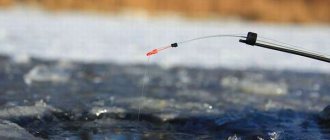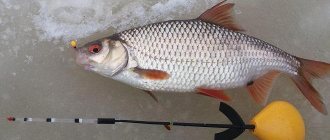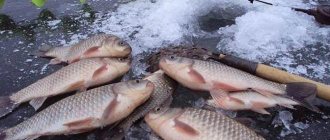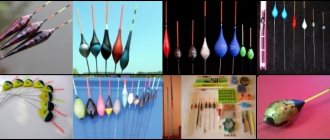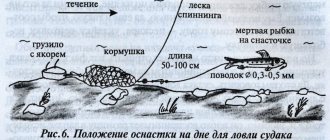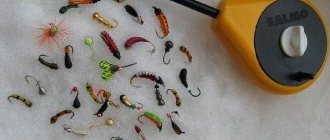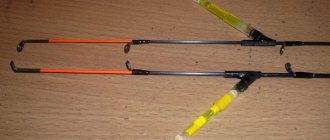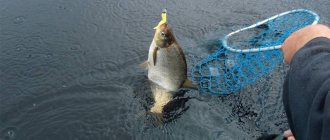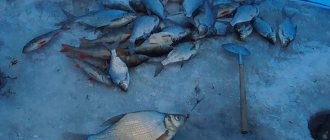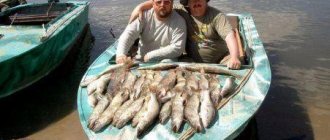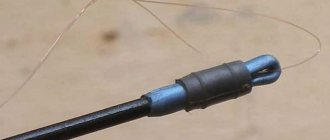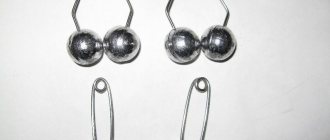Active jig fishing in the current sometimes turns into a stumbling block. And fishermen avoid such river places. However, small and medium-strong currents in winter can bring catches even better than fishing in still water. There are no special or special jigs for fishing on currents in winter - it’s all about the equipment and the correct technique. Sometimes subglaciers make the mistake of using the usual jig for still water throughout the current. This is the reason for the failures. Deadlift work requires a different approach. And these efforts will pay off - there are more fish on the riverbed in winter, and larger specimens are caught. You just need to slightly change your approach to technology and equipment.
Features of fishing on the current
At great depths under traction conditions, standard thin equipment and a small jig do not work. More precisely, it can only be used in very weak currents, as long as the strength of the flow allows you to control the bottom with the bait. For stronger traction, you need to use heavy jigs, special equipment, or generally fish with a riser or with winter ice bottoms. And if the main places for ice fishing in winter are rivers, then you need to think about an integrated approach. That is, to be armed with various methods and gear, using them depending on the strength of the current.
The current forces the use of heavier and less sensitive equipment - and this is often a stumbling block for seasoned jig fishers, but only in reservoirs with standing water or weak draft. However, there is no other way out - the strength of the flow does not allow the use of ultra-sensitive standard jig equipment and a pool of familiar fishing rods, which fishermen have their hands full with. What saves the situation is the fact that the fish are active on the stream. In order to stay in the flow, underwater inhabitants expend a lot of effort; the oxygen regime in such places is normal, and as a result, the fish actively feed. Its bites in such places are more daring and bold. There is simply no time to savor every bit of food - otherwise the fish will remain hungry.
Color choice is important
- In winter, being at decent depths, the fish still pays attention to the colors and tones of the bait. It is clear that the larger the bait, the more noticeable its shape and color. Such jigs should not alarm or scare off future prey with their appearance, but, on the contrary, attract even the most distrustful fish.
- The most optimal and universal colors for heavy mortars are black and purple. But striped bass are more interested in the color of brass. Jigs in dark green and dark purple tones have proven themselves well when catching roach and perch without using a bait.
- Moreover, the baitless option, as practice shows, is often quite catchy, but for this the angler must have a good understanding of the behavior of representatives of the under-ice space, which are the main food for the fish at the moment.
Active jig
We discussed stationary ice fishing with fishing rods in the current in the article at the link provided. Here we will analyze active fishing for the game with one fishing rod, with constant control of the gear. The bottom line is that fishing conditions should be divided into two types - depending on the ability to control the bottom with the gear used for fishing. In weak currents (or medium currents with shallow depths), you can work with the usual gear, including baitless bait, only heavier (from 0.5 grams). In strong currents, a heavy sinker is included in the rig. The game is played by tensioning and releasing a loop of fishing line, inflated by the current, without lifting the heavy sinker from the bottom (in place) or by releasing it (pull) under the ice. By the way, it is advisable to use these two fishing methods on the same gear.
Angler's tactics
The technique of playing with such jigs does not differ in any intricacies.
- An important feature is its vertical movement, periodically making “down-up” movements and at the same time slightly swaying.
- During the first ice, when the fish is still active, the movement can be faster, and the amplitude of oscillations is greater.
- In the dead of winter, the fish are inactive, so the jig should play slowly.
It is better to choose places for fishing with heavy jigs with a depth of 4 to 6 meters and a weak current; sometimes you can explore shallower areas. The main thing is to detect a concentration of fish. We recommend reading the article about fishing rods for winter fishing.
Bottom control
The success of playing a jig in the current with conventional equipment is based on two pillars - correct installation and special play for these conditions. Standard saw, herringbone and dribbling do not work. You just need to not curse the flow in your head, but find a common language with it and use the physical properties of the flow.
The selection of the nod, the thickness of the fishing line and the weight of the jig is carried out so that the tackle is held at the bottom after lowering. At the same time, when lifting the gear, for example, 20 cm from the bottom, the working descent increased by 10 cm (50%). Accordingly, this distance will need to be lowered from the reel - this means that the jig has been pulled further under the ice by the current (but is not carried - the bait has stopped again). The difficulty is that such gear cannot be prepared at home in advance - all manipulations are carried out already on the reservoir, at a specific depth and strength of the current. You need to take a thin fishing line - it simply has less windage, therefore, such a monofilament is not strongly inflated by the current. Alternatively, instead of one heavy jig, you can use a steam locomotive of 2-3 smaller ones.
Traditional fishing on the rise is not used. In the current, we catch it on release, tugging the tackle in small steps. At the same time, the jig moves under the ice a little further each time. It is at this lowering after rising that 90% of bites occur. The drag limit is determined by the nod - you can let go as long as the bait is felt. Then, in the reverse order, we raise the fishing rod, but now we don’t lower it, but wait until the jig goes to the bottom against the current. Thus, you can’t work with high-frequency oscillations here - you get rises and falls of the jig, slowed down by the current. At the same time, even when stationary, the bloodworm on the hook moves, which additionally attracts fish.
Playing on a loop
In a strong stream, on which even a tungsten jig cannot hold, a heavy sinker is added to the rig at the end of the fishing line. A working jig (heavy fly) is tied 30-40 cm higher by a locomotive or on a lead leash. Soft nods are not suitable for such fishing, nor are too hard ones. The desired option can only be selected experimentally. The game is a careful pulling of a line loop inflated by the current without lifting the sinker from the bottom and releasing it back.
At the same time, the jig moves diagonally to the bottom (if it’s heavy, it can even reach it) and back. This method is used to catch roach and grayling in the current. However, it is still better to place the jig on a retractable leash. In this case, if there are no bites on the tension, we switch to catching without changing the equipment. At the same time, the sinker is still selected not too large, usually 10-20 grams. With enough lift, it should come off the bottom and be pulled under the ice.
Pull (let down)
Winter fishing with a jig on the current in the winter by pulling is carried out in the same way as rolling with bottom tackle. In essence, it’s the same thing, it’s just that on the leash it’s not a hook with bait, but a jig. The installation was not carried out inline (sliding), but on a branch lead. The sinker with the leash moves further with the current. In this case, it is important to catch the rhythm of the nod movement. A bite is often noted as a delay in the movement of the guard.
The leash with the jig is freely stretched by the current and does not get tangled with the main fishing line. The main thing is to make the twitches smoothly and briefly, without sharp and long jerks. The farther from the hole, the more amplitude the swing of the hand is - after all, you also need to select a loop of fishing line from the stream. And so on to the limit - arms raised above the head at the top point of the swing at the farthest distance. Then - in reverse order. In this way, a large area of water is fished - up to 20 meters downstream.
The principle of stream fishing
The best jigs for bream for winter fishing with photos: recommendations for fishing with them
What jigs can be used to successfully catch bream in currents and in still waters:
- Ant. The jig attracts with its catchability and ease of use. A baitless bait can provoke even the most passive fish thanks to its spectacular behavior in the water, its shape and vibrations during retrieval. The ant works great, both in the classic version and with the addition of colored cambric and beads. Optimal colors for bream: yellow, black, red, white. The jig attracts bream best with small-amplitude fishing during warming periods. The domain is reservoirs without a current, larger models from grams can be used on rivers with a slow current.
- Pellet. Classic jig fishing. Use bait with bloodworms, maggots, and worms. She catches not only bream, but also perch and roach. The jig is suitable for both experienced fishermen and beginners, due to the fact that it is easy to learn. Advantages: ease of use, easy to obtain, attractive appearance. There should be several options for pellets: silver, copper, black.
- Nymph. The bait is quite popular among winter anglers. Due to its oblong shape, it is at a slight angle in the water. The jig is already available for sale with different cambrics/beads. This additional element significantly increases the likelihood of catching the coveted trophy. The most successful wiring option here is the herringbone (saw). In this case, the jig moves in choppy movements, drawing out the teeth of the saw. We lower the jig to the bottom, then smoothly detonate it by 10-15 centimeters and pause, let the jig fall by 7-10 cm. Then again smoothly detonate and pause with the fall. This is how a Christmas tree is obtained in several iterations, reaching 50-70 cm. In this version, the bream bites even in the dead of winter, and can also be used as a mothless fish. It is necessary to make stops at the top and bottom points. Bites most often occur during a pause. For a slow current it is good to use nymphs with a ring, as in the photo, for a current - without.
- Banana. The jig is quite in demand; it is used for catching bream, perch, and roach. For greater efficiency, place a bloodworm on the hook. Upgrading the bait with all kinds of cambrics/beads only improves the quality of ice fishing. The banana is also interesting for its interesting vibrations, which force the fish to attack.
- Cobra (and its variant cuttlefish) - often used when fishing for bream as a reelless bait, attractive for its external design. It works with any fish activity. The only thing you need to do is choose the right size. Larger jigs are ideal for active bream, and smaller ones for passive bream. The advantage of the cobra is that it is promising in all weather conditions. There are two types: with one and two hooks (cuttlefish). Most often, good results are obtained when using baits on the tummy of which a round eye with a red pupil and a yellow/white outline is drawn.
- droplet. This jig works methodically and efficiently with replanting of bloodworms, jigs, and maggots. The game should be quite active and at high frequencies. The catchability of this bait is ensured by its shape. It creates attractive vibrations during play, which provoke fish to grab and bite.
- Uralka. The most popular bait among fans of ice fishing for bream in winter. It reminds the fish of its usual food - mormysh. It is especially effective when combined with wiring. First, the Uralka is lowered to the bottom, then it is sharply pulled 30 cm up and released so that it returns to its original position. Then you need to slowly raise the bait, using different frequencies, amplitudes, choosing the best solution. A universal option, it can be used in rivers and standing reservoirs.
- Ovsinka has proven itself in bream fishing exclusively on the positive side. It is used mainly in calm reservoirs without current; in large sizes from 1.5-1.8 grams, the jig can be used for catching bream in slow and moderate currents. Can be used either as a stand-alone unit or in combination with bait. Ovsinka shows its effectiveness where others fail. Without bait, the bait for use as a baitless bait is equipped with colored cambrics/beads.
- Carnation (nail ball, nail cube) It is distinguished by its versatility and catchability. There are several variations of it: nail cube, nail ball, nail gun, etc. Nail balls, as a rule, are used on bream; nail cubes are used a little less often. This jig is a must have for ice divers. You can catch bream, white bream, roach, perch, silver bream, and blue bream.
- Devil. The bait is popular as a reelless bait - by far the most interesting and promising for winter bream in this class, capable of provoking even the most passive fish. It can be used on both peaceful representatives of the reservoir and predators. The main advantage is the attraction of trophy specimens. It is important to find a way to present the bait - however, this is a characteristic feature of any reelless fish.
TOP 3 catchable jigs for catching bream and roach in winter according to Andrey Gribachev’s rating:
Search tactics
Everything we have considered assumes that the angler is at a known catch point. That is, this is the final stage - a place has been found and fishing takes place. It’s good if the reservoir is “home” and the points are known. If not, a huge amount of time can be spent searching for fish. Search tactics are directly related to the bait system. Holes are drilled in the selected water area, usually at different depths, and fed. Then you need to devote time to each one and fish it in order to find out in principle whether it bites or not. If the results are positive, we feed thoroughly. In a weak current, the bait can be lowered directly into the hole, in a strong current - in a special large feeder. The fisherman’s task is to combine the eroded spot and the fishing line with the tackle. Fish do not wander far in winter, preferring not to waste extra energy. And it will stand right on the stern strip, where edible particles rush along the bottom and in the depths, getting stuck in uneven areas.
All fishing with a jig in a strong current comes down to this combination of factors - stopping the fish at a specific point (with the help of bait) and bringing the hooks with bait to this nickel of the bottom. If you miss by a meter or two, you may not get a single bite (in the worst case, if there is no active fish).
Subscribe to the channel:
My YouTube channel RYBAFAN on fishing:
We're OK
Search for a place
In winter, the main places:
- Channel channels;
- Recesses of elongated shapes;
- Equal bottom of reservoirs and lakes with a depth of up to 5 meters;
- Flooded riverbeds and lakes;
- On the upper edges of rivers;
- On the water lower stages.
Bream lives in these places for most of the entire season. With the onset of a thaw, it begins to move. Use an echo sounder as your main assistant in searching for fish in water resources.
The device will indicate an accumulation of fish, after which you can begin to lower the gear. We advise you not to make noise, no shouting, and no waving of your arms. Remain completely calm.
Expert opinion
Valery Andreevich Sizov
Professional fisherman with 35 years of experience
To catch a couple of dozen, prepare gear for different holes around a small perimeter.
Reservoir depth
Much depends on the depth of the fishing spot and the size of the desired trophy. What jigs are used and at what depths:
- At a depth of up to 4 meters, pear-shaped, drop-shaped products with a weight of no more than 0.3 grams and a diameter of 2.5 mm are used. The tackle is used to catch white bream on the first ice.
- From 4 to 7 meters, elongated jigs with a weight of 0.6 grams and a diameter of 3.0 mm are used. Lures are suitable for river backwaters from mid-winter.
- For depths of 8 meters, use products of 0.8 g with a diameter of 4 mm. The baits are suitable for flowing lakes and reservoirs.
The basis is tungsten with a high density. Other types are not used.
But modern fishermen are trying their best to make gear from any available materials, mixing their shapes, colors, using their own fishing techniques.
It should be said that experienced fishermen can find new species in their arsenal, which naturally are not on sale in specialized stores.
Summer jigs
Catching baits are equipped with phosphorus. The weights are coated with special paint. Let's look at their advantages and disadvantages:
- You can fish at night. The burning glow attracts attention at depth. Fishing at night in the summer creates excitement that lasts until the sun rises.
- Creates an increase in bite.
- Works on cloudy and rainy days.
Of the minuses:
- You often have to charge it with a flashlight or under the sun.
- The paint wears off quickly. Experienced fishermen apply special varnishes containing phosphorus.
- At shallow depths, they can scare away fish.
Select the jig in your own way. What does it mean? Apply several options and choose the one that suits you.
It is worth noting that in most cases, regular bait can be more beneficial than phosphorus bait. We recommend supplementing this type with attachments in the form of dough pellets or oatmeal porridge.
In natural reservoirs, you can lure bream out with a worm or fatty maggot. It is also good to use sandwich options. It is advisable to hide the hook tip with dough balls.
Optimal wiring plays a special role in catching bream. The fish can circle nearby and wait for the moment when interest appears. Fishing with a float with a jig should not hang without effect. What does it mean?
Many fishermen lower the tackle into the water and look at the float, which should respond to the actions of the fish underwater. This rarely happens.
This means we need to act, to play a rare smooth game. The tackle should play underwater and subside for a few seconds. There is no other option for catching a trophy. You shouldn't rely on luck.
Bream loves to crowd around growing trees and plants in the water. But for fishermen, this is an opportunity to break off expensive gear.
What is the way out? Fishing from a boat will help you accurately place the jig at the desired point on the terrain. The fishing line will not break and will remain intact.
